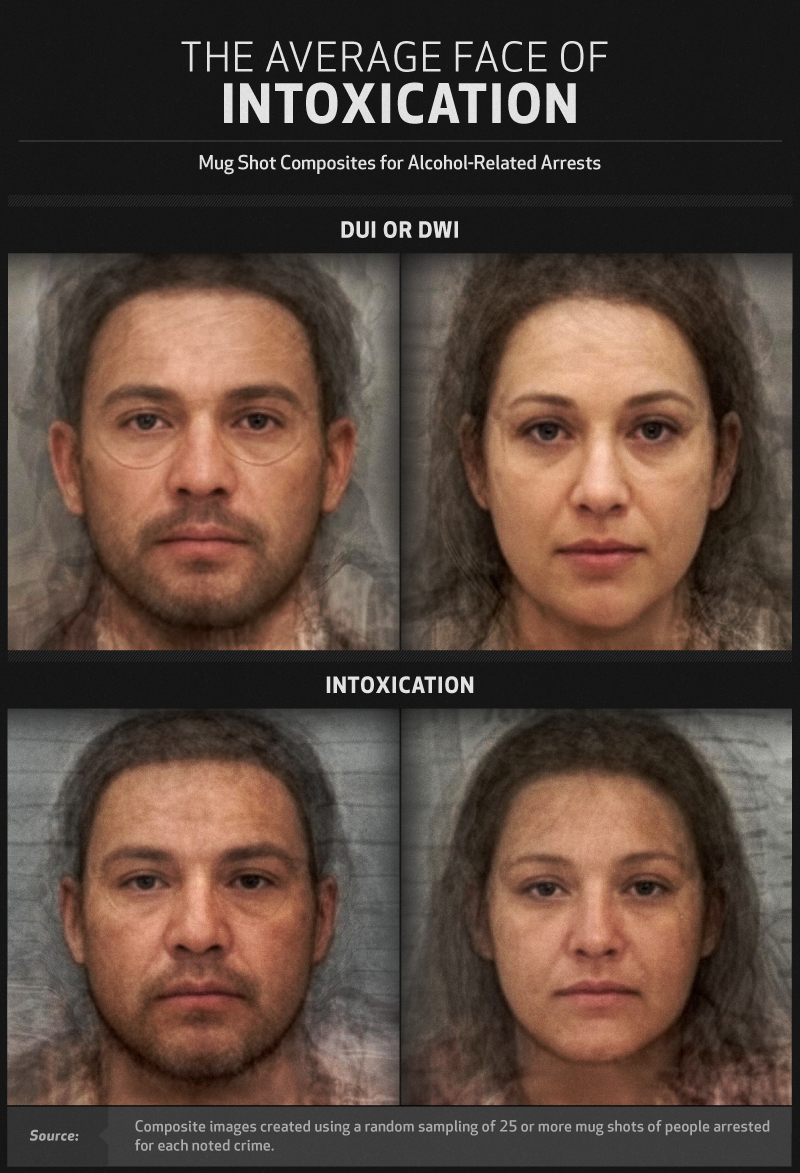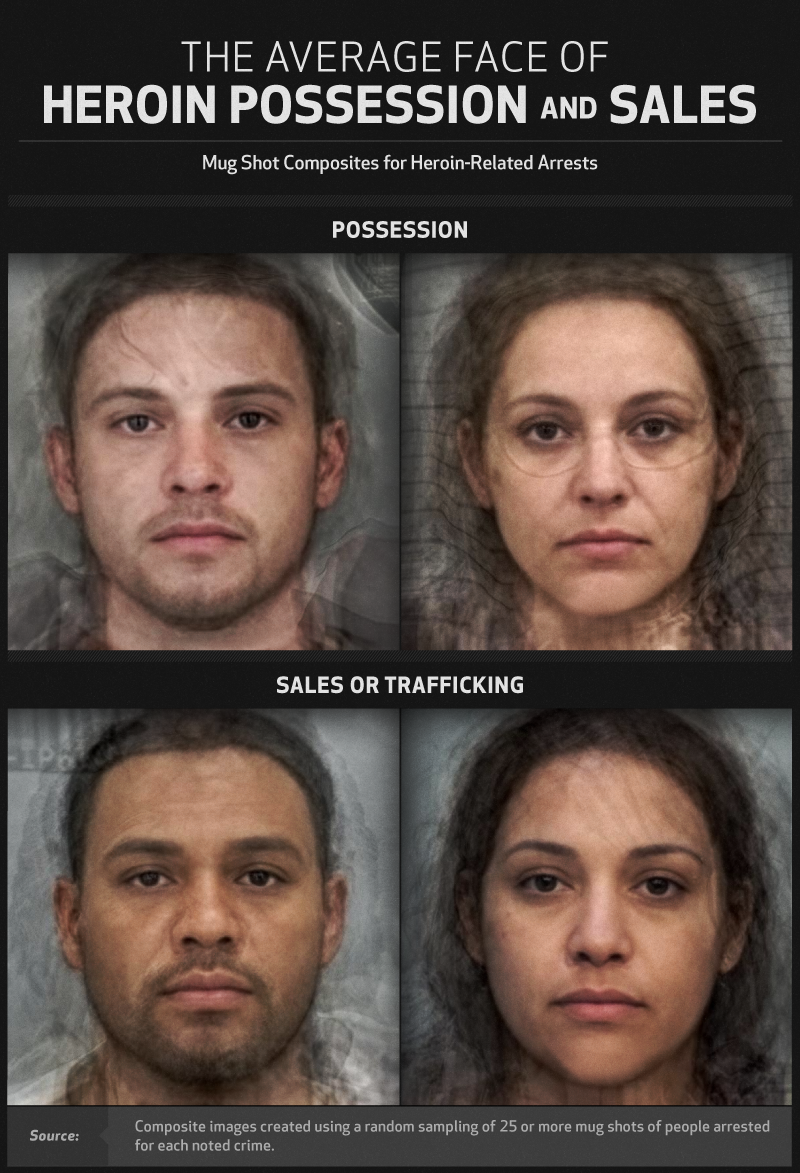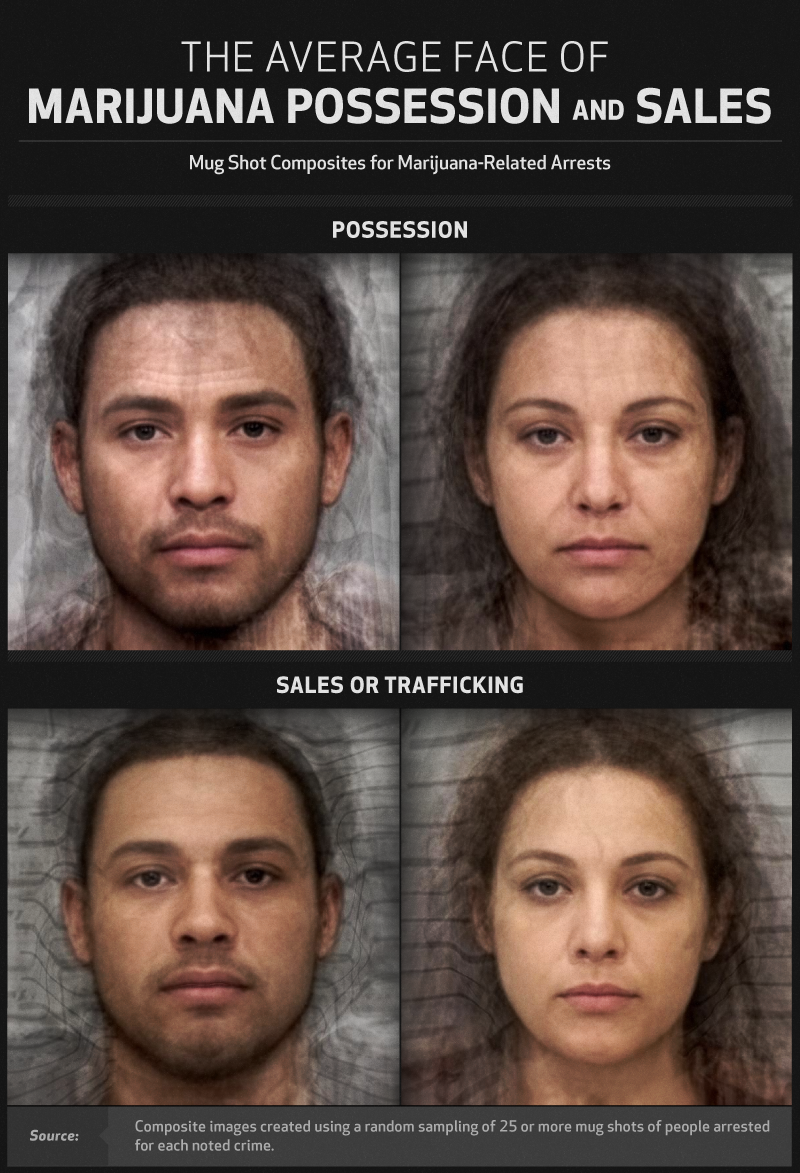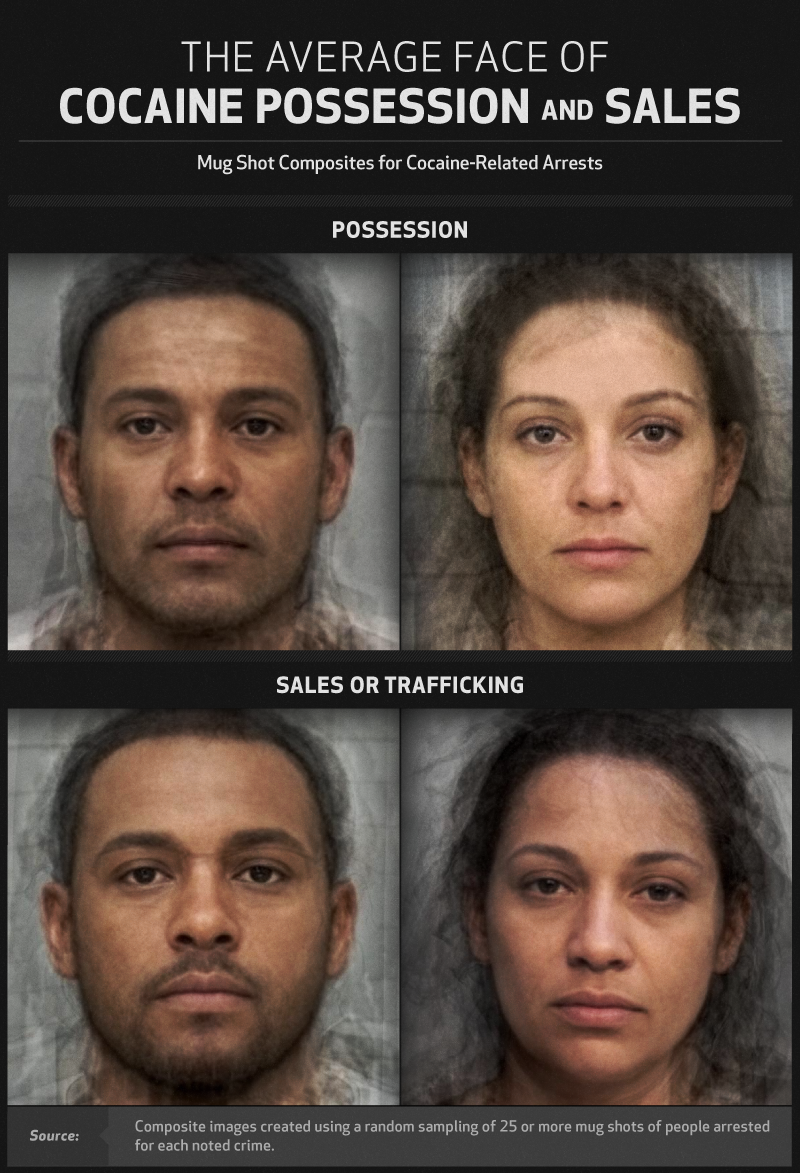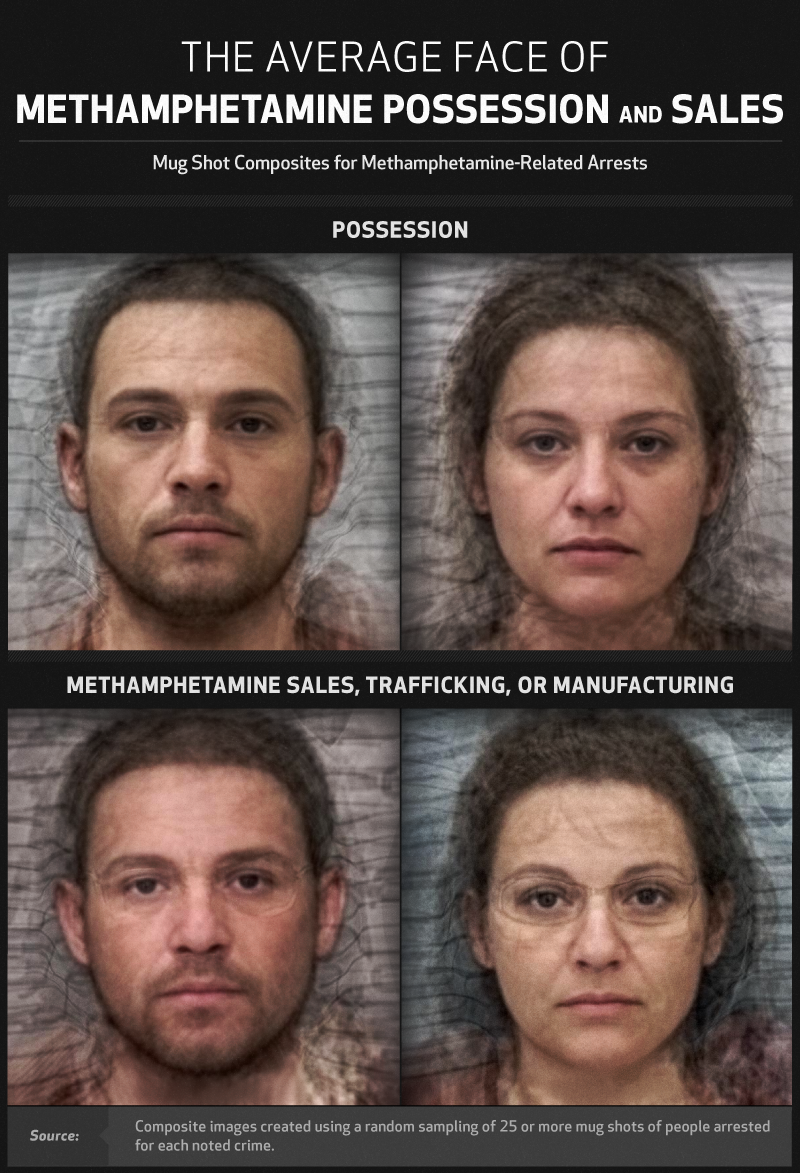Substance abuse has never been contained within a single section of the American public, but our current drug crisis seems particularly indifferent to demographic differences.
Research suggests that while men are still more likely to use drugs, the opioid epidemic has disproportionately affected women. Similarly, while opioid deaths have been concentrated in white communities in recent years, new data show overdoses rising among people of color. Other substances are impacting new groups as well: Methamphetamine use is crossing ethnic and socioeconomic lines, while older adults are drinking alcohol to excess like never before. Clearly, there is no single face that represents the country’s drug troubles.
For this project, we set out to provide a pictorial representation of the people swept up in the use and sale of various substances. To do so, we created composite images of dozens of mug shots depicting individuals arrested for possessing or selling drugs. Our work does not intend to imply a connection between criminal activity and certain appearances – rather, it is meant to highlight the diverse range of people who are using and selling drugs. To see the faces of the drug epidemic across America, keep reading.
Arrested Under the Influence
The first category of mug shots included individuals arrested for impaired driving offenses. The terms “driving under the influence” and “driving while intoxicated,” alongside their associated acronyms, can be easily confused: Most states use one or the other, though some employ both to denote differing degrees of intoxication. For the purposes of this project, we combined DWI and DUI arrests into a single category. It’s worth noting that such offenses extend beyond being drunk behind the wheel: Law enforcement agencies have struggled to enforce laws against marijuana intoxication while driving, a concern in places where medicinal and recreational pot have been legalized.
Our second set of composite pictures referred to arrests for bad behavior while intoxicated in public. The general public may be most familiar with such charges thanks to the embarrassing exploits of high-profile figures, such as actor Shia LaBeouf or college football superstar Baker Mayfield. Interestingly, our composite photos showed minimal evidence of the redness and puffiness around the eyes that typically occurs following a night of drinking. Perhaps the subjects were still intoxicated when these photos were taken, with hangover symptoms yet to become apparent.
Haggard by Heroin
In recent years, researchers have consistently noted the prevalence of opioid addiction among white Americans in particular. Our composite photos of individuals arrested for heroin possession may bear witness to this demographic trend, with both the male and female images exhibiting lighter skin tones. Of course, possession charges aren’t the only crimes associated with the opioid epidemic ravaging the country. Police in affected areas are having to confront other directly related challenges, including petty crimes committed by users to fund the purchase of drugs.
However, in the composite photos of those arrested for heroin sales or trafficking, we can observe a decidedly darker skin tone. This held true for men and women alike. Indeed, these pictures may present visual evidence of racial disparities in the criminal justice system: Federal data indicate that 80 percent of those convicted for heroin trafficking are either black or Latino.
Pot Mug Shots
Our composite images for those arrested for possessing marijuana lacked the classic signs of cannabis intoxication: Bloodshot eyes were nowhere to be found in the male or female photos. This may indicate that the subjects were not high at the time they were arrested, but simply carrying the substance instead. Whatever the case may be, the consequences for marijuana possession charges differ vastly across the country. Many states have decriminalized possession entirely (up to a specific quantity), whereas other places treat holding any amount of marijuana as a felony.
As one might expect, marijuana arrests have dropped significantly in states that have legalized the drug in recent years. However, although arrests have declined overall in those states, racial disparities have remained, with people of color still far more likely to be charged with selling marijuana.
Cocaine Consequences
Law enforcement agencies report that cocaine’s availability in America has increased in recent years, in part because of increased production in Colombia, the top exporter of the drug to the U.S. This trend may be disproportionately affecting black communities across the country: The drug is the largest contributor to overdose deaths among black men and women. In fact, cocaine overdose deaths among black Americans are roughly equivalent to opioid deaths among white citizens, though the latter has received more public attention.
These trends may be evident in the composite photos of men arrested for selling or possessing cocaine, which yielded some of the darkest skin tones in our study. However, the composite images for women arrested for cocaine-related crimes had significantly lighter skin tones. The history of cocaine interdiction in America is fraught with racial implications: In the ’80s, sentencing laws imposed much tougher standards on crack than powder cocaine. These laws eventually led to the disproportionate incarceration of people of color, whose communities were more likely to be ravaged by crack than cocaine.
Marks of Meth
The physical effects of methamphetamine are widely known: From extreme weight loss to skin sores, the physical consequences of meth use can be quite striking. Our composite images did not reveal many such signs, though one major visual indicator was not on display by default: Meth users often experience severe dental problems, but few people show their teeth in mug shot photos.
The lighter skin tones in these composite photos were to be expected: Meth has historically been linked to white Americans, particularly those living in poverty. Interestingly, however, the main source of meth sold in the U.S. has changed significantly in recent years. Historically made in remote labs in rural communities, methamphetamine is now predominantly manufactured by Mexican drug cartels. As the supply chain shifts, methamphetamine may find its way into new communities across the country.
Picturing Recovery
To some extent, these images are most notable for being unremarkable: The faces of those arrested for offenses related to drugs and alcohol possess no distinctively criminal features. Given the pictures presented in this project, it’s impossible to dismiss drug use as a problem affecting a single demographic. Rather, our composite images suggest that the real faces of America’s drug epidemic are all around us, though we may not always perceive their struggles.
If you’re struggling with substance abuse yourself or worried about a loved one’s addiction, the pervasive nature of the nation’s drug troubles may hit particularly close to home. But just as individuals from all walks of life are contending with chemical dependency, there’s a diverse and growing community of Americans who are embracing recovery. With expert guidance and the right treatment options, you or your loved one can join them on the path to well-being. Explore our information and resources today to learn about affordable and effective treatment options.
Methodology
For this project, we collected a random sampling of mug shots from multiple arrest websites. Photos were grouped by “crime description” and then segmented by gender. A random sampling of 25 to 45 images were used to composite each face average. More information on facial averaging can be found here.
Fair Use Statement
Find our mugshots interesting? If you’d like to share our content on your own site or social media, you’re free to do so for noncommercial purposes. Simply link back to this page to attribute our team for their work.



